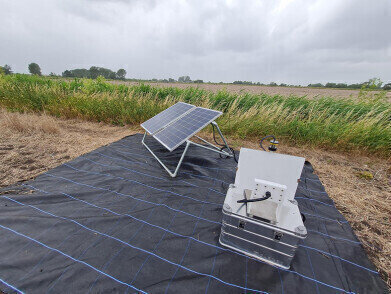Business News
AI enables scientists to monitor the environmental impact of farming on biodiversity
Sep 12 2023
Scientists are using automated wildlife sensors and artificial intelligence (AI) over the next four years to demonstrate the effectiveness of agri-environment and peatland restoration schemes in improving biodiversity.
The UK Centre for Ecology & Hydrology (UKCEH) will be deploying solar-powered biodiversity monitoring stations comprising camera ‘traps’ and acoustic recording equipment at farms across the country to monitor the presence of insects, birds, amphibians, bats and small mammals.
There will be stations at farms that are undertaking practices to reduce emissions, increase carbon capture and support wildlife, such as agroforestry and wildflower hay meadows. Stations will be placed in areas of the farm that do, and do not, have agri-environment measures, and will be used to measure the impacts of these schemes on species populations.
They will also be located at degraded peatland areas to compare species populations on farms which remain drained for agricultural use and nearby sites that are being rewetted to provide wetland habitats that support biodiversity and absorb carbon dioxide from the atmosphere.
Researchers will then use AI software to identify species from the photographs or recordings of their calls.
The study is part of AgZero+ which is an ambitious, UKCEH-led five-year research programme supporting the UK’s transition towards domestic food production that is sustainable, carbon-neutral and has a positive effect on nature.
Professor Richard Pywell of UKCEH, who is leading the programme, explained the monitoring study would build on the institute’s long-term research which showed setting aside some land for agri-environment measures had a positive effect on biodiversity and did not affect overall crop yield.
“Mounting evidence suggests that populations of many species of insects, birds and mammals are in sharp decline in the UK and across the world, and a key driver of this change is intensification in agriculture,” he said.
“Using the latest technology, we will monitor species at farms that have different crop and land management practices, to demonstrate how a range of farming systems and agri-environment measures affect populations. Our monitoring will provide scientific evidence to inform sustainable land management policies and practices, which have a positive effect on biodiversity and mitigate climate change while enhancing crop production.”
Initially, automated stations with lighting to attract moths and high-resolution cameras to capture images for subsequent identification via AI are being set up over the summer at 10 sites, with two stations at each. The study will be at four pairs of farms, in Dorset, Wiltshire, Oxfordshire and Northamptonshire, to compare the impact of agri-environment schemes and two peatland sites, one which is being farmed and another which is being restored, in Cambridgeshire.
Moths and their caterpillars are crucial parts of ecosystems, being food sources for birds, bats and other small mammals, and amphibians, so are excellent indicators of biodiversity and quality of habitats. Moths are also important, yet underreported, pollinators of many flowers.
From next year, the stations will also have acoustic equipment to record the calls of bats, birds, amphibians and small mammals, which will then be identified via AI.
UKCEH will redeploy the automated monitoring stations at additional sites across England each year, being in operation between March and October in 2024, 2025 and 2026.
Dr Tom August, a computational ecologist at UKCEH who is overseeing the deployment of the automated biodiversity monitoring stations, explained: “New sensor and AI technology is transforming the way ecologists monitor biodiversity. Automated biodiversity monitoring stations with solar power allow us to monitor wildlife round-the-clock in remote locations without being on site, while AI technologies allow us to process the thousands of images and recordings they produce far faster than a human can.”
UKCEH will present its findings after completion of the four-year study though preliminary data will be available during the project.
Data from the study will support the biodiversity net gain strategy. From November, most developments in England must not only have no overall detrimental impact on biodiversity but enhance it by 10 per cent. Some of the peatland areas that will be studied by UKCEH will include sites being restored to compensate for damage to biodiversity due to development at nearby land.
UKCEH’s biodiversity monitoring stations will create a better understanding of how quickly populations of species respond to peatland restoration, providing important evidence for the wider biodiversity impact of biodiversity net gain.
Digital Edition
IET 34.2 March 2024
April 2024
Gas Detection - Biogas batch fermentation system for laboratory use with automatic gas analysis in real time Water/Wastewater - Upcycling sensors for sustainable nature management - Prist...
View all digital editions
Events
Apr 30 2024 Melbourne, Australia
Apr 30 2024 Birmingham, UK
May 03 2024 Seoul, South Korea
May 05 2024 Seville, Spain
May 06 2024 Minneapolis, MN, USA



















